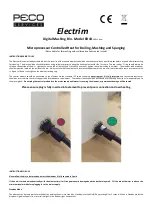
WF-140
ST
/ WF-180
ST
© Weldclass | E.&O.E. | Edition 1.1 | 2019.05.03
45
5.
Properly install and ground this equipment according to national, state, and local codes.
6.
Turn off all equipment when not in use. Disconnect power to equipment if it will be left
unattended or out of service.
7.
Use fully insulated electrode holders. Never dip the holder in water to cool it or lay it down on
the ground or the work surface. Do not touch holders connected to two welding machines at the
same time or touch other people with the holder or electrode.
8.
Do not use worn, damaged, undersized, or poorly spliced cables.
9.
Do not wrap cables around your body.
10.
Connect work piece to a good electrical ground.
11.
Do not touch the electrode while in contact with the work (ground) circuit.
12.
Use only well-maintained equipment. Repair or replace damaged parts as soon as practical.
13.
In confined spaces or damp locations, do not use a welder with AC output unless equipped with a
voltage reducer.
Arc rays from the welding process produce intense heat and strong ultraviolet rays that can burn eyes and
skin. Use the following table to select the appropriate shade number for a Welding Helmet or Welding Face
Shield.
Recommended Protection Fillers For Electric Welding
Welding Process / Application
Approximate Range of
Welding Current in Amps
Minimum Shade
Number of Filter Lens
Stick (MMA)
Up to 100
8
100 to 200
10
TIG
Up to 100
10
100 to 200
11
Table 16
14.4.6
Fumes And Gases
WARNING!
Welding produces fumes and gases. Breathing these fumes and
gases can be hazardous to your health.
1.
Keep your head out of the fumes. Do not breathe the fumes.
2.
If inside, ventilate the area and/or use an exhaust at the arc to remove welding fumes and gases.
3.
If ventilation is poor, use an approved supplied-air respirator (PAPR).
4.
Read the Safety Data Sheets (SDS) and the manufacturer’s instruction for the metals,
consumables, coatings, and cleaners.
5.
Work in a confined space only if it is well ventilated, or while wearing an air-supplied respirator.
Shielding gases used for welding can displace air causing injury or death. Be sure the breathing air
is safe.
6.
Do not weld in locations near degreasing, cleaning, or spraying operations. The heat and rays of
the arc can react with vapours to form highly toxic and irritating gases.
7.
Do not weld on coated metals, such as galvanized, lead, or cadmium plated steel, unless the
coating is removed from the weld area, the area is well ventilated, and if necessary, while
wearing an air- supplied respirator. The coatings and any metals containing these elements can
give off toxic fumes if welded.
Содержание WeldForce WF-140ST
Страница 19: ...WF 140ST WF 180ST Weldclass E O E Edition 1 1 2019 05 03 19 WF 140ST Figure 11 WF 180ST Figure 12 ...
Страница 20: ... 20 Weldclass E O E Edition 1 1 2019 05 03 8 4 Primary Schematic Circuit Diagram Figure 13 ...
Страница 25: ...WF 140ST WF 180ST Weldclass E O E Edition 1 1 2019 05 03 25 Figure 23 ...
Страница 50: ... 50 Weldclass E O E Edition 1 1 2019 05 03 NOTES ...
Страница 51: ...WF 140ST WF 180ST Weldclass E O E Edition 1 1 2019 05 03 51 ...
Страница 52: ... 52 Weldclass E O E Edition 1 1 2019 05 03 www Weldclass com au ...








































